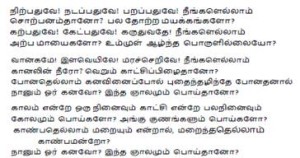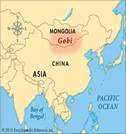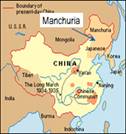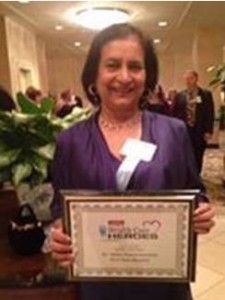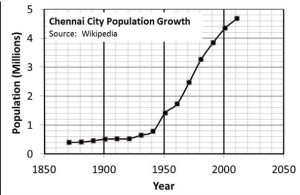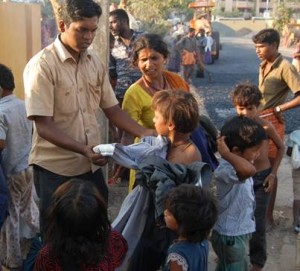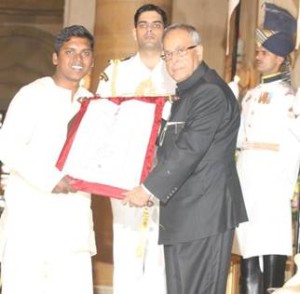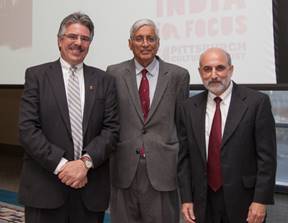Archive for category January 2016
Rajyasree Ghosh’s Mesmerizing Vocal Recital
Posted by admin in January 2016 on December 28, 2015
By Seema Chaubey, North Huntingdon, PA
e-mail: seemachaubey@hotmail.com
The last of the Chhandayan house concerts of 2015 held on Saturday, October 31, at the Sahas’ home in Irwin, PA, presented Smt. Rajyasree Ghosh from Kolkata, accompanied on the tabla by Pt. Samir Chatterjee, the founder of Chhandayan. Pt. Chatterjee has been teaching tabla in universities for over thirty-five years and is well known in his field. Ayon Rivu Sinha of Pittsburgh was on the harmonium. The recital provided a wonderful blend of pure Hindustani classical music and Thumri, Dadra, Kajree, bhajans and Tappa.
Rajyasree is on the faculty of music at the Rabindra Bharati University, Kolkata, in India. She trained under four legendary gurus — Pt. Amiya Ranjan Bandopadhyaya of the Vishnupur Ghrana, Padma Bhushan Girija Devi of Varanasi, Pt. Arun Bhaduri of Sangeet Research, and Pt. K.G. Ginde of Belgaum. The unique signatures of the different gharanas were reflected in Rajyashri’s recital.
Rajyasree started most aptly with an early evening raga Shyam Kalyan. Her melodious and sonorous voice instantaneously captured the mood of the raga with its haunting interplay of both the suddha and tivra Madhyam and its emphasis on Re in the vilambit segment of the raga. The words of the song balama rasiya bhara lingered, resonating in our ears even when she transitioned into drut teen taal. Perfection is the way to describe the rendition of this raga in her strong and melodious voice with her control of bols, taal and sur. Next Rajyasree presented a drut segment of the raga Narayani, a bandesh in teen taal composed by S. N. Ratanjankar of Agra Gharana.
After a brief intermission, she transitioned into semi-classical music and presented three Thumris, which were illustrative of varied gharanas, taals, tempo and ragas. Kajri, a genre of semi-classical music popular in northeast India, often expressing romantic love, is sung during monsoon; Barse karire baderia mor chunariya bhije jai was lively and simple in its style and yet exquisitely spiced with subtle sargams in between.
There were more Thumris of the popular Benaras gharana such as nanadiya kahe mare mon based in Desh and Na jayo piya pardesh in Shivaranjani.
Tappa, a form of semi-classical vocal music coming from the rural Punjab, became popular in Bengal and in the royal courts. It consists of a rolling pace based on fast and subtle constructions, and the mood is laden with the emotions of a lover. Rajyasree presented both slow and fast paced Tappa compositions in Hindi and Bengali. Emotions of devotion and romance were subtly expressed in Radha and Krishna’s divine play in the song Rai anga sajabo diye ki bhushan. Her knowledge and skill in the genre was reflected in the various forms of the genre presented, such as Nidhu Babu’s Bengali tappa, Rabindranath Tagore’s Tappa, and a Hindi version of Miya me janewale.
Rajyasree ended her debut with a Dadra style devotional song and a shyama sangeet in praise of Mother Kali. Tabla support by the maestro Pt. Samir Chatterjee, as always, was outstanding. The duo created an atmosphere of lingering harmony as the notes and rhythm blended into unison.
As is usual, there was a delectable potluck dinner at the end of the recital in an informal setting during which those present interacted with the artistes of the evening.
Subramania Bharati on the Illusions and Transience of Life
Posted by admin in January 2016 on December 28, 2015
By Kollengode S Venkataraman
Subramania Bharati, (1882 –1921), simply called Bharatiyaar out of love and reverence by the Tamils, is the bench mark in Tamil literature, particularly in poetry. His impact is so profound that Tamil poetry today is seen as Pre-Bharati and Post-Bharati.
His full name is Chinnaswamy Subramania Aiyar. Bharati, meaning “one endowed with the blessings of Saraswati, the Goddess of Knowledge†is the title he received for his poetical skills when he was barely eleven.
His was a multifaceted personality. He was a freedom fighter, poet, essayist, journalist, social reformer, linguist… He spoke passionately on the emancipation of women, untouchability, social equality…
Despite his great gift, he died in 1921 in penury, with his cremation attended by only a handful of people. He was 39. He was deeply religious and spiritual. He made Tamil poetry — till that time, a topic only among the Tamil vidwans (scholars) -– enjoyable for all the Tamil-knowing people, whether urban or rural, educated or uneducated, rich or poor. He was also a Brahmin. Despite Bharatiyaar’s great contributions to Tamil literature, there was, and still is, ambiguity among many of the powerful leaders of the anti-Brahmin and obsessively Tamil-loving Dravidian Movement to recognize Bharatiyaar for his gift to the Tamils as a people, and to Tamil as an old classic language in every sense of the terms “Classic” and “Old.”
Bharatiyaar wrote a famous and popular song, Aaduvomay pallu paaduvomay… (“Let’s dance to folk tunes declaring, ‘We got the blissful freedom…’â€) on the joy of Indians celebrating freedom. He wrote this poem prophetically more than 25 years before India’s independence. His life was recently filmed in the biopic Bharati portraying his life realistically.
Bharatiyaar also wrote on philosophy in verses conforming to the rules of poetry, and also in free style. Here is one of his poems on the illusory and transient nature of life, first in the Tamil script, and then as a free-style translation.
This song was nicely portrayed in the biopic on his life, with Ilayaraja scoring the music. The song is available on this link: https://www.youtube.com/watch?v=nx91opkZ09I.
Here is a free-style, non-literary, but truthful translation:
O, You, standing still*, or moving on your feet*, or flying on wings*!Â
Are you all only dreams? Are yours only phantom appearances?
O, all that we study, learn, listen, and contemplate,
Are you only trivial illusions? Don’t you have any deeper meaning?
O, the open skies, the gentle sunshine, and trees in the woods!
Are you all a mirage? Just errors of my hallucination?
All that have gone-by just vanished, buried as in dreams,
So, am I also a dream? Is this world also unreal?
The idea of time, and the scenes reminisced from memory,
Are these only mental tricks? And their features are lies too?
If everything seen will disappear, and all that vanished were once seen,
Am I also only a dream? Is the world around me is a fantasy too?
* Reference to plants, animals, and birds.
———-Â
Bharatiyaar raises these questions without trying to answer them. He probably wants readers to seek answers for these eternal questions from their own life journey. One does not have to be old to pursue this. After all, Bharatiyaar was only in his 30s when he wrote this poem. Even high school students entering college can ponder over these queries with their own adolescent experiences. Others can look at them against the background of their successes and disappointments in their careers, love and married life, social climbing, material acquisitions, and get better insights into life’s quirks and complexities.  ♦
Pure Fiction: Gobi Manchurian
Posted by admin in January 2016 on December 28, 2015
By Kollengode S Venkataraman
One of the craziest items in Indian restaurants these days is Gobi Manchurian. The name sounded familiar for geographical reasons. I remember in my high-school geography taught in Tamil that there was a desert called Gobi. In the Tamil script, there is only one letter for both “Pa†and “Ba.†So, I read it as Gopi desert and thought this was the desert in northwest India around Gujarat and Rajasthan. I later learned that it was not Gopi, but Gobi desert; what was shocking was that it was not anywhere in India. It was between Mongolia and China, over 1000 miles from India’s northern borders. See map above.
In India, the craze du jour is Chinese food, with Chinese restaurants first appearing in upscale areas. And seeing a good market for Chinese food among the wannabe gora, but very brown desi “foodies,†Indo-Chinese restaurants sprang up everywhere, literally spicing up the traditional Chinese fare of noodles/rice with fish, chicken, lamb, and goat, but avoiding other Chinese delicacies, such as snake, turtle, and jelly fish that don’t sit well with Indians. Seeing a good demand for these modified Chinese fare, even 100% shudh vegetarian joints all over India started adding Chinese noodle items flavored with Indian spices and soy sauce, making hybridized Indo-Chinese items. One item — called Gobi Manchurian — became really popular in all Indian restaurants all over the world.
Again, I vaguely remember from my school geography, Manchuria was somewhere in China. Since Gobi Manchurian is popular in Indian restaurants, I thought Manchuria should be somewhere in the Indo-China border region. When I searched Google, I was in for another shock. Manchuria was in northeastern China bordering Russia, separated from India’s northern border by over 1000 miles. See the map on the side.
Then I went to northeastern China on work. In all the Cantonese, Hunan, and Shandong food I ate there, nowhere did I see anything called Gobi Manchurian. Not only was nothing called anything closer, but none looked anything like the desi Gobi Manchurian in presentation or taste.
Then I imagined that a Malayali cook, Gopinathan (Gopi for short), might have gone to northeastern China as a migrant worker. There he concocted a dish hybridizing his native Kerala-style cooking with vegetables he found in China — cauliflower (called Gobi in northern India), bell peppers, mushrooms — with the spices he brought from Kerala. When he returned to India, he started his own restaurant adding this item, calling it Gopi’s Manchurian, which later morphed into Gobi Manchurian.
Even this explanation — however self-serving it was because I am from Kerala — did not satisfy me. Even my Google search didn’t help. And then I came across this comment in a blog from a guy from Bangaluru:
“Reminds me of a Chinese guy called Eugene Chiu I met off and on over a period of 2 years whenever he visited Bangalore. The one thing he loved about India was… hold your breath… ‘Chinese Food.’
“ ‘Indians make Chinese food better than the Chinese themselves,’ said Chiu. His favorite dish was, believe it or not ‘Gobi Manchurian.’ It was quite a novelty, because you can’t find Gobi in Manchuria. So that is one Indian hardware making its way into Mainland China.â€
There it is, guys and gals. Gobi Manchurian is a 100% Indian concoction, having nothing to do with Mongolia, Manchuria, or China. If you have evidence to the contrary, I am all ears.  ♦
Dr. Nilima Karamchandani Receives The 2015 Health Heroes Finalist Award
Posted by admin in January 2016 on December 28, 2015
Urvashi Surti, Ph.D., O’Hara Township, PA
Congratulations! Dr. Nilima Karamchandani, MD, specializing in neonatology, was the finalist for the Lifetime Achievement Award for this year’s Health Care Heroes Award. In an event organized by the Pittsburgh Business Times with High Mark Blue Cross Blue Shield as the presenting sponsor and Allegheny Health Network as the event sponsor, Dr. Karamchandani received the honor on September 9, 2015, in their annual event at the Omni William Penn Hotel.
Dr. Karamchandani has spent her entire professional career ensuring that the most fragile new-born babies in western Pennsylvania have a fighting chance to live a normal, healthy life. As Chief of the Division of Neonatology and Medical Director for the Infant Apnea Center at West Penn Hospital for the past 37 years, Dr. Karamchandani has been a nationally recognized authority in neonatology, particularly in treating infant apnea and preventing Sudden Infant Death Syndrome (SIDS).
Under Dr. Karamchandi’s leadership, West Penn Hospital’s Neonatal Intensive Care Unit (NICU), the leading referral center in western Pennsylvania for sick and premature newborns, now cares for more than 700 babies each year. At West Penn, she established one of the country’s first infant apnea centers and the developmental follow up program for premature infants.
As a founding board member of the Greater Pittsburgh SIDS Chapter, Dr. Karamchandani also served as president of the National Association of Apnea and the American Association of SIDS and Safe Sleep Programs. She has published numerous scientific papers on infant sleep apnea and risk for SIDS, while also helping lead clinical trials of new medications to treat deadly infections in infants.
Of her many accomplishments and contributions to neonatology medicine, Karamchandani cites her research with SIDS and development of educational programs to reduce the incidence of this devastating fatal condition as the most important. Among these initiatives was the national “back to sleep†campaign (now called the “Safe to Sleep†campaign) that is credited with significantly reducing SIDS deaths in America.
For her dedication and commitment, Dr. Karamchandani has received a long list of accolades and recognition over the years, including the city of Pittsburgh’s “Women in Medicine Achievement Award†in 2005, Celebrate & Share’s “Woman of Achievement in Medicine,†award, membership in the Guide to America’s Top Pediatricians by Consumer’s Research Council of America, and “Top Doctor in America†recognition by Consumers’ Guide to Top Doctors.
Nilima was a graduate of Seth G.S. Medical College and King Edward Memorial Hospital, affiliated with the Bombay University in India. As a daughter of an Indian Air Force officer, Nilima spent her childhood all over India. Her mother was a professor of English.

Nilima with her two patients, Becky Brindle in 1972 and her premature grand daughter 43 years later.
Karamchandani did her fellowship in neonatology at Magee Womens Hospital. She has also trained new generations of physicians and other healthcare professionals in neonatology and pediatrics, serving as a clinical assistant Professor of Pediatrics at both the University of Pittsburgh School of Medicine and Temple University School of Medicine.
She lives in Fox Chapel with her husband Manu Badlani, PhD, a mechanical engineer. They have three sons and three grandchildren.
Decades ago, when we were looking for a pediatrician for our daughter, Dr. Nilima Karamchandani was our obvious choice. I had known her as a fellow student in Mumbai at St. Xavier’s College. In 1972, Dr. Karamchandani had already been in the local paper during her training for saving a prematurely born baby when others had given up. Karamchandani also delivered a normal baby for one of her patients decades ago, whose daughter had a premature delivery under Dr. Karamchandani’s care. See the picture of all three with Karamchandani.
Dr. Karamchandani retired this July. Her other interests include travel, embroidery and reading. She is also busy traveling to her sons and taking care of the grandchildren. The Karamchandanis are on the board of trustees of the Hindu-Jain temple. Nilima is at present the president of the Triveni International Club. ♦
The Chennai Floods – How A Natural Event Became A Man-Made Disaster
Posted by admin in January 2016 on December 28, 2015
By Kollengode S Venkataraman (December 2015)
Chennai, the fourth metropolis of India with a population of nearly 5 million people in the city and over 8.5 million in the expanded metro area, was inundated with incessant rains during November starting from Deepavali. This is the normal northeast monsoon season for the east coast of Southern India. Chennai received over 140 cm of rains (2.5 cm = 1 inch) during a 2-week period. This was unusually high against the normal annual rainfall of 45 cm. Such high rainfall happened nearly one hundred years ago, and was probably spread over a much longer duration. But Chennai city’s population was only 0.5 million then, with much less population density, because high-rise buildings were unknown. See the plot.
Climate change on account of human recklessness on a global scale is one contributing factor for this excess rainfall. But other local contributing factors, centered on Chennai’s reckless urbanization and growth, made the natural event into an urban disaster. Every other urban areas in India — New Delhi, Mumbai, Kolkata, Bangaluru, Hyderabad, Kochi-Ernakulam and other emerging cities — has similar foot prints in reckless urbanization. In the future, urban planners in India will use — or at least should use — the Chennai Floods of 2015 as a bad example on what not to do in urban development.
In the Tamil medium high school social studies class we were taught that the geographical area around Chennai, in the absence of any river basin, has a unique irrigation system for farming. This system, called Aerip-Paasanam in Tamil, has been in vogue for over a millennium, as the historical records show. Aerip-Paasanam, literally means Lake Irrigation. The whole region is relatively flat without any large river system like the Kaveri, Krishna, and Godavari delta in Southern India. The local rulers and land owners over the last 1000 years dug large tanks and built lakes, and de-silted them periodically, to collect the rain water during the 2 to 3 month monsoon season. They used the water thus pooled for irrigation for raising at least two crops annually. Old maps of the area show the area dotted with hundreds and hundreds and hundreds of water bodies, big and small.
Even in Chennai City, many places, before they were renamed as fancy Nagars (Anna Nagar, Kalaignar Nagar, Indira Nagar…), had the word Aeri (lake) attached to them, as in Velacheri, Otteri, Nungambakkam Aeri, Mambalam Aeri. These densely populated places, now innocuously called “low-lying areas,†were once actual lakes.
In the last 40 to 50 years, India has seen huge migration of rural population on a national scale to urban centers all across the landscape. Both the educated and the poor from every region have moved in millions into every other region on a scale unheard of to get better jobs, or simply to eke out a living.
Obviously there are great pressures on every resource in urban India, such as housing, drinking water, sewage, transportation, schools, shops for all kinds of goods and services… India’s expanding middle class has increasing access to many resources that come with education, wealth and money. However, India’s middle class and the affluent do not want to pay taxes, but expect all kinds of services from governments (ref:www.tinyurl.com/G20-IndiaTaxBase).
In Chennai’s case, the unenlightened self-interests of the segments listed below got aligned with disastrous consequences in the 2015 Floods: populist and corrupt state and local elected governments; vote-bank politics; ever increasing middle class needs for goods and services; people’s unwillingness to pay for it in taxes; land, real estate, and construction mafia; an acquiescing bureaucracy and criminal justice system; and the simple human greed to get rich quickly in the real estate boom. NRIs too would have contributed to this with their access to hard currencies.
In recent decades, in Chennai and other urban centers, politicians started real estate businesses in the names of their spouses, sons, family members, making huge commissions in real estate transactions. They have all the inside information in governments, and use strong-arm tactics to acquire urban and suburban land. In this environment, the lakes and low-lying areas became multi-story housing complexes with fancy names within the city and in the suburbs along the new freeways. These freeways were also built along the low-lying areas, often built across river beds. Government buildings, private hospitals, glitzy IT “campuses,†even private universities, were built on the lake beds.
Chennai once had 12,000 hectares of ponds and lakes (1 hectare = 2.5 acre) for collecting the rain water. Today it has only 600 hectares. And the three small rivers that drain the Chennai’s rain water into the Bay of Bengal are today open sewers. The estuaries of these rivers are not dredged regularly to facilitate the draining of rain water into the sea. And the larger lakes in the region are not dredged regularly and kept in good repair to increase their water storing capacities.
The migrating rural poor people have occupied the catchment areas around these rivers and the river beds themselves — where else can they go? — to eke out a living. With vote-bank politics having become the standard, elected governments have “regularized†the occupancy of people living in these low-lying areas, giving them titles for the land. Having obtained the land for free, they built regular houses on this land.
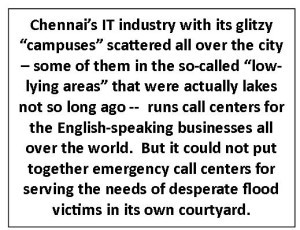
In this rain season, the first floors in the multi-story housing complexes built with government approval were flooded with 6 to even 10 feet of water. These people have lost their personal belongings and suffered heavy losses. Those occupying higher floors, even though did not suffer personal losses, would see their net worth reduced because of the drop in the market value of their apartments. Here are the samples of pictures of the Chennai Floods of 2015: http://tinyurl.com/Pics-ChennaiFloods .
Even if 200,000 apartments need to spend, say, only Rs. 200,000 per apartment for repairs , you are talking about Rs. 40,000,000,000, or Rs. 40 billion, or 4,000 crores in personal losses. Then they need to rebuild roads and other damaged infrastructure. Many thousands of poor people have lost their whole house built on the “regularized†lands along the river bed granted to them for free. There is no way any government can compensate for these people’s personal losses.
So, we cannot call it a “natural†disaster, any more than Katrina was a natural disaster. The 2015 Chennai rains is a severe natural event that became a man-made disaster by the reckless omissions, commissions and sins in urban planning, and in the management of urban growth, and tardiness in preparing for the monsoon by the elected governments. And this was made worse by the total lack of respect for the land, its terrains and its environs by every Chennai-vasi, both rich and the poor, educated and the uneducated, powerful and the weak. But the onus on the rich, educated and the powerful for this man-made disaster is far greater. Every Chennai-vasi – the anglicized would hate this rustic term, their preference is Chennaiites – has directly and indirectly contributed to this disaster.
But as it happens in India, nobody will be held accountable and nobody will own up responsibility for the man-made disaster. Those responsible will hide behind Climate Change and the Act of God.
This man-made disaster needs a drastic package of solutions requiring thousands and thousands of crores of rupees and long time frame to get to the root causes and then fix them. Some of these are: restoration of the natural ponds and lakes all along the coastal areas prone to puyals, cyclones and hurricanes; a plan in place for the periodic dredging of the estuaries of the three rivers in Chennai at the sea, and keeping water flowing in the rivers snaking around Chennai. These rivers are cesspools now; resettling the poor people living along the riverbeds and basins in safe places and giving them homes they completely lost; and keeping the river beds free from future encroachments. These are not easy.
Since every Chennai-vasi has directly and indirectly contributed to this disaster, every one of them also has to pay for it for fixing it, maybe through a 0.5% Floods Tax on their income and a small raise in sales tax. After all, they have been making their money out of Chennai’s growth.
This requires a major course correction in the lifestyles for the Tamil society as a whole, particularly among the educated Tamil established classes and its political and social elites since they are the trendsetters. Arasan evvazhi, avvazhi makkal, or Yatha raja, tatha praja. The Tamil society and the sizable non-Tamil residents of Chennai metro area need to understand and respect their own ecosystem and design a lifestyle around it, rather than transplanting a lifestyle that worked somewhere else faraway under different ecosystems. Whatever is true to Chennai is true for every other Indian metro area.
Long term, India has to evolve a policy to disperse its population in newer smaller cities all across the nation instead of making the existing metro areas grow and grow, till they simply collapse, as Chennai did.
On media coverage, the Tamil print media did a far better job in getting the historical information on the regions’ water management policies over the last 800 to 1000 years by going to original sources in the Tamil language. Here are the examples:
1. tinyurl.com/Dinamani-MaraVendumManobhavam by N Gurusami
2. tinyurl.com/varumum-kAvathAn by R. Rajagopalan
3. tinyurl.com/katrukkolla-maRukkiROm by Mr. K. Pazhanitthurai
The titles of the articles in translation tell everything about its contents: The Mindset Has to Change; The Life of the Person Who Never Prepares; and We Refuse to Learn.
The English print media (The Hindu and others) did a pretty bad job on this point. This is understandable. Both its anglicized writers and semi-anglicized urban readers are completely cut off from their own hinterland linguistically, culturally, and ecologically. END
A Remarkable Story on Compassion & Caring
Posted by admin in January 2016 on December 28, 2015
By Krishnaa Raman, Savannah, GA
e-mail: araman83@aol.com
Recently, I was in Kochi, India, to be with my only sibling, my sister Meena, to mourn the passing of my mother. One of my uncles happened to be visiting from Delhi, and he performed the cremation rites and the ceremony of mixing the ashes with the waters of the Arabian Sea. According to tradition, women cannot perform the subsequent eleven days of the last rites for the departed, and so my sister and I decided that we would feed the poor and destitute on three days. We also felt that Amma would be very happy with our decision!
My sister talked to one of her friends who suggested going to this building where Murugan, an auto rickshaw driver, takes care of about thirty people. We got to his place at 11:30 am and arranged with a caterer to bring lunch around noon time. This young man of thirty-two, Murugan, has photos of getting recognition from the President of India, Sri Sri Ravi Shankar and other notable people; laminated copies of all the articles written about the work he has done were on the wall.
I asked him how he got involved in this work of rescuing street children and the really poor, destitute people on the streets.
“I had spent ten years in an orphanage, because my father was an alcoholic. Brother Mavooris, a well-known social worker in Kochi, gave me a new lease on life at Don Bosco Snehabhavan, taught me to speak and write in Malayalam, and helped me complete my high school education in the open school system.Â
“I then decided that I am going to help children who were wandering in the streets. I did not want to ask for donation. So, I learnt to drive an autorickshaw for funds to support this cause. So far, I’ve rescued over 2,000 children.
“I have developed a procedure for this to get support. I inform the police when I see a child on the streets before taking them to the orphanages where I feel they will be safe and also get an education. I also follow up on their care.â€
“How do you end up taking care of adults too?†I asked.
“In the last few years, I saw older people on the street abandoned. I started picking them up; many are mentally ill and physically sick. I get the police involved, give them a bath, take them to a hospital where the doctors who I personally know, and who know my work, can check them out and give them proper treatment. They give these people medicines. I transport them for court appearances if needed, and then find an institution to take care of them. Some of them now live in a building that the city has donated to me.
“I have a few goats for milk, some chickens for eggs, and a vegetable garden. I recently received ambulances donated by a large petroleum company. In spite of the publicity I’ve received from the press and television, I am often short of funds for the care of these abandoned people. The problem is so huge.â€
I was awe-struck to see what Murugan has accomplished at his young age! How does an eighteen-year-old know what his life’s purpose is? Then how does he focus in on working towards that goal with his own situation so precarious?
Murugan told me he does not ask anyone for funds, but manages with whatever he gets. Evenings are spent driving his auto rickshaw, so he can support his wife and his new-born baby and get the funds required for “his people.â€
His daytime is devoted to his social work, taking care of the people no one wants. I consider it a blessing that I got to meet Murugan, someone extraordinary. Meeting Murugan has renewed my faith in humanity.
To know more about the details and challenges of Murugan’s work, go to www.theruvoram.org.
Youthful India
Posted by admin in January 2016 on December 28, 2015
Premlata Venkataraman
For decades, I recall from my younger days, India’s thinkers and rulers described its population as a problem in political discourse. But these days, India’s Prime Minister Modi frequently boasts on the global stage that India is filled with youthful energy, with 30% of its 1.25 billion people between the ages of 6 and 30 years. He is deftly turning the tables on looking at India’s younger population as an opportunity, if only we know how to harness it.
During a recent visit to India, this heady exuberance was staring at me wherever I went. It was no idle boast. Living in Pittsburgh with an aging population — Pennsylvania is one of the most geriatric states in the union — we have become accustomed to see aging people running airports, shopping malls, grocery stores, and a slower pace of life.
In direct contrast, just landing in India brings one face to face with the energetic bustle of India’s youth.Even arriving at the sparkling new airports in Kochi, Bengaluru, Hyderabad, Mumbai or New Delhi, you see everywhere young employees in slick uniforms striding along briskly, ready to solve passengers’ problems. If one feels a little gray and tired in the face of this energy, rest assured, it is not just the long journey, but India’s bubbling youth staring at you.
Of course, as India’s youth seek the holy grail of success, what they need is quality education and skills allowing them to compete locally and globally. Doors are literally opening for educated, skilled, and qualified Indians all over the world. In the changed atmosphere in India today, even IITs have opened more campuses. Engineering colleges, especially those in information technology and computer science, have chaotically sprouted up throughout the land to meet the demand. Indian youth is so attuned to opportunities that if there is a slight drop in demand in certain fields, the enrollments in colleges in those disciplines drops drastically, much to the chagrin of the new colleges without reputation.
Needless to say, for young people, having the right multinational employer and an upwardly mobile career give a lot of disposable money. India’s new consumer economy is looking precisely for this demographic slice to grow and prosper. It is no surprise that there is a mall in every suburb, selling the most upscale designer merchandise, and bars and food joints all around.
Young people with more money than their parents and grandparents had accumulated over their lifetime live a lifestyle that is quite alien to the elders. Eating out at fancy eateries, dressing in the most fashionable clothes and driving high-end foreign automobiles have become quite de rigueur. Throw in also weekend jaunts to Sri Lanka, Thailand, Singapore, and Dubai for singles…
At the fancy new airports in India, you find affluent young parents with children in tow going on vacation to the choice spots of the world. Not long ago, flying in India was for the wealthy and businessmen; for others, it was usually only for family emergencies.
But the picture is not all rosy for the new Young India. If manufacturing and service sectors are not able to provide jobs for teeming millions, they will hit turbulence. Countries having a lot of young people who don’t have jobs encounter social unrest. Look at Greece and Spain.
If India is to avoid this, its federal and state governments and its burgeoning businesses need to grow at a pace fast enough to absorb its young with jobs. For this to happen, its manufacturing and service sectors have to further expand, for which a good infrastructure is necessary.
As long as every segment of India feels that it is getting a slice of the pie, there will be economic mobility and hence social stability.   ♦
Duquesne University School of Law Hosts “Gandhi: The Lawyerâ€
Posted by admin in January 2016 on December 28, 2015
By Meghan Collins
Duquesne Law Student and Juris Editor-in-Chief
Note: Shankar Rao Dittakavi, a long-time resident of this area and a well-wisher of the Patrika from its very first issue, is Associate Director at the Duquesne University Center for Legal Information and Allegheny County Law Library. He informed us of this program.
On Thursday, November 5, 2015, Duquesne University School of Law presented an insightful program exploring Mahatma Gandhi’s young life as an attorney in India and South Africa and how the years impacted his future as an international human rights leader.
Dean Ken Gormley organized “Gandhi: The Lawyer†and moderated the panel discussion with two Gandhi scholars: Rajmohan Gandhi and Charles R. DiSalvo.
Rajmohan Gandhi is the grandson of Mahatma Gandhi and a well-known author, scholar and humanitarian. In his career, he has written extensively on South Asian history with a special focus on dialogue and reconciliation between divided communities, including between Hindus and Muslims in South Asia.
Charles R. DiSalvo is the award-winning author of M.K. Gandhi, Attorney at Law: The Man before the Mahatma (Berkeley: University of California Press, 2013). He holds the Woodrow A. Potesta Professorship at the West Virginia University College of Law, where he teaches on civil disobedience.
Mahatma Gandhi, as most people know, was one of the greatest figures of peace in the 20th century. Yet many people do not know that Gandhi was formally trained as an attorney. It was during his time in London that he began to find his calling as a civil leader for the people of India.
The panelists introduced interesting insights into Gandhi’s journey and who he was as a man rather than solely as a political figure.
Gormley asked why Gandhi’s transformative experience of getting forcibly kicked out of a first-class train car in South Africa because he was not white was so significant.
Charles DiSalvo discussed that it was this moment coupled with a courtroom incident, where Gandhi was told to remove his turban, which inspired Gandhi to do something about the way Indians were treated.
“In South Africa, when he found his purpose, he found his voice,†said Rajmohan.
Rajmohan said of Gandhi, “His genius was finding a way to involve millions of people while pointing out the absurdity of British rule.â€
Gormley ended the discussion by asking how Gandhi’s training as a lawyer and his experiences as a lawyer helped shape the person he was, and ultimately what his legacy is.
Charles DiSalvo commented that “The most important thing [that he took from being a lawyer] was that he was turned into a public person; he learned to think, speak, and act in public. He could speak to crowds of thousands of people for hours without notes.†Ultimately, Gandhi’s legacy, says DiSalvo is “whether the work we are doing reaches our deepest moral and political values.â€
Rajmohan said that Gandhi taught us to “[live] for something much more than for ourselves.â€
Duquesne University presented “Gandhi: The Lawyer†in association with the Pittsburgh Cultural Trust’s India in Focus cultural showcase.  Â
The Pittsburgh Patrika’s Twenty Years
Posted by admin in January 2016 on December 28, 2015
By Premlata Venkataraman

With the October 2015 issue, The Pittsburgh Patrika crossed a milestone. It was 20 years ago in October 1995 that we mailed our very first issue of the magazine. It was a nebulous idea coming true for my husband Kollengode S. Venkataraman, who is a news junkie by habit, an aficionado of Tamil classics, a dabbler in eclectic things here and there, a man with opinions on many facets of life, and willing to put them on paper. Incidentally, maybe accidentally, he is an engineer by profession.
When he bounced around the idea of a magazine for the Indian diaspora, most of the advice he got was that there would be only minimal interest. Since most of the activities then, and still now, occur at religious centers with their own newsletters, there really was nothing else to cover. With our two daughters still in school and the huge cost of their college education staring at us, we set out to give the venture a try, mentally ready for the magazine’s neonatal death.
In the first issue, Venkat wrote, “This newsletter is a forum for airing and sharing your views, ideas, even frustrations, on any matter of topical and not-so-topical interest. [We, the Indians here] have quite a diversified background, and yet are so very alike. When we look through our patina of sophistication, we often see that our pleasures and pains, anxieties, concerns, hopes, expectations, even griefs, are similar. The Patrika’s intention is to entertain and inform people who share a certain value system, and are curious about what is going on in our midst… … If you feel strongly on any matter…, now you have a forum to air it.â€
The first issue (with no advertisements,) only talked about the intent of what the future issues would cover. Vividly we remember now: we did not want to staple the magazine on its spine since that would involve an additional $8 for the 400 copies!
Early on, we decided the focus would be on our Indian and American experiences relating to our lives in Western PA, something neither fully Indian, nor presumptuously American, to echo the evolving identities of Indian immigrants who now call Western PA their home. The name Pittsburgh Patrika truly reflected our pan-Indian and yet American identity in Western Pennsylvania, in which Pittsburgh has a dominant presence.
On these points, your magazine, all through these twenty years, has stayed true to what it set out to do. We do cover stories/trends/political upheavals that occur in India and here as well, but always keeping the focus on how it relates to our lives here.
While covering the events put together by the Desi Diaspora here, we are astounded at the vibrancy of the talented people pursuing different facets of our culture. Whether it is Holi, Garba, Pongal, Diwali, India Day, or Gandhi Jayanti, we are ready to gather and party! Covering these events and getting to know the organizers has been a lot of fun.
When we started, our understanding was that we attended our temples, went to our weekend parties, liked cultural programs, and were always preoccupied with our children’s discipline and education. But we were astonished by the treasure trove of hidden talents in the community and were enthusiastic to highlight the best of India and integrate it into the American mainstream: music teachers and talented dance teachers and their students, artists, painters, henna artistes, social activists, fundraisers for local causes, volunteers in mainstream organizations. Highlighting these activities has been the most satisfying part of running the magazine. We must here acknowledge the conducive atmosphere of multiculturalism encouraged in the US.
In recent years there has been a trend for fundraising for many local causes by Indian-Americans here. Staging music and dance shows or even organizing 5-K walkathons to help those less fortunate in our neighborhood is a very healthy, welcome trend. Giving greater visibility to these events in the magazine, we hope, ensures more participation.
Personally it has been an educational and humbling experience for us in this small undertaking. While researching stories and interacting with people coming from different parts of India, we realize how much more we all have in common. With more and more of our youngsters intermarrying among ourselves and with mainstream Americans, we will come together as a single community uniting under the banner of our Indian-American identity, even as we integrate rapidly into the American mainstream.
Another point is that articles in The Patrika are authored by people living right here among us. This makes the magazine interesting reading. We thank these writers for their interest. We acaknowledge our reader’s kind words they tell when we meet them in social gatherings.
Many young people who have “grown up†reading The Patrika still visit us on Facebook and the web page. It is gratifying when you tell us how eagerly you look forward to the next issue and how you read it through in one sitting. And we cherish articles writen by some of these youngsters. So thank you for your interest.
Publishing this magazine in our spare time was a challenge with sporadic work-related domestic and overseas travel. Also, we neither seek nor get any grants from governmental, social, cultural, religious organizations, or corporate or charitable foundations. We believe that in the Free Market environment, any activity has a reason to exist only if it is able to at least pay all the bills on its own. Depending on grant money often saps the vitality of organizations, especially, magazines.
Our only source of revenue for meeting the ever-increasing cost of printing and mailing the magazine to nearly 2000 homes every quarter is advertisements. So, we owe our very existence to our advertisers for their support and confidence in our integrity.
We profusely thank our advertisers and look forward to serving you and our readers better in the years ahead. We also thank a handful of well-wishers who, on and off, on their own and out of goodwill, send us voluntary contributions in support. ♦


